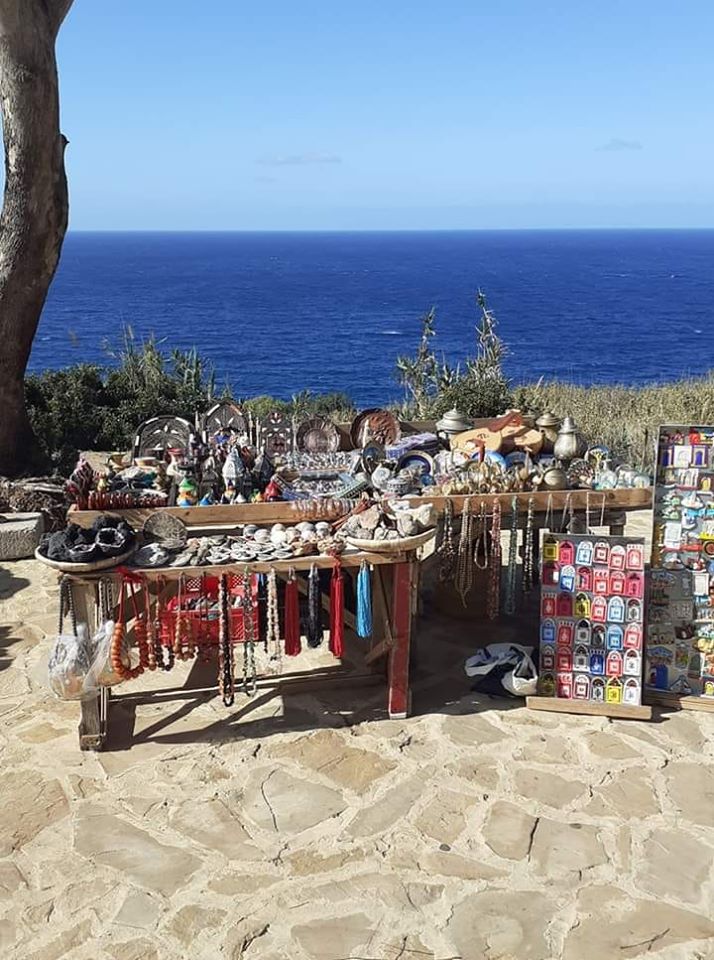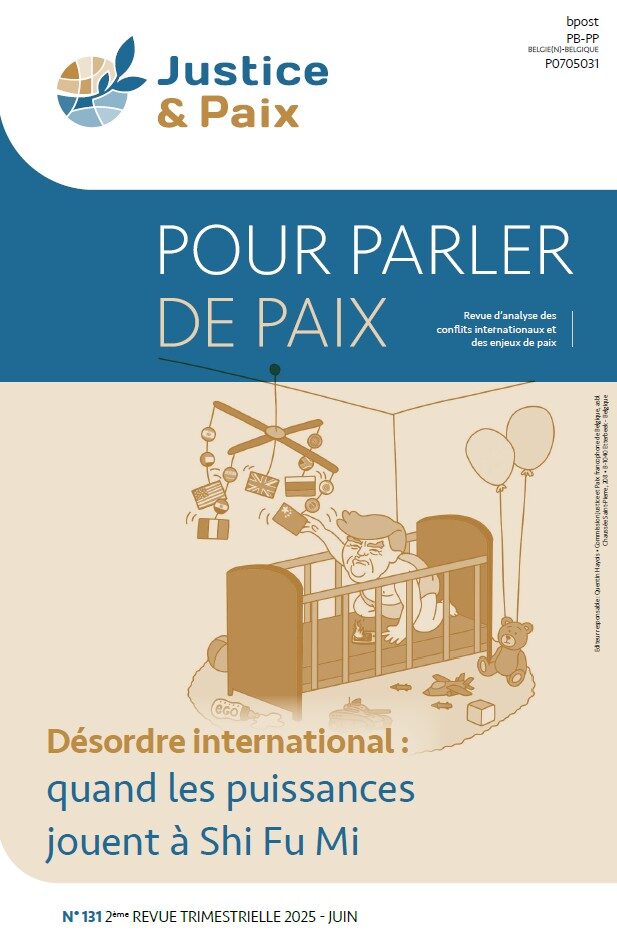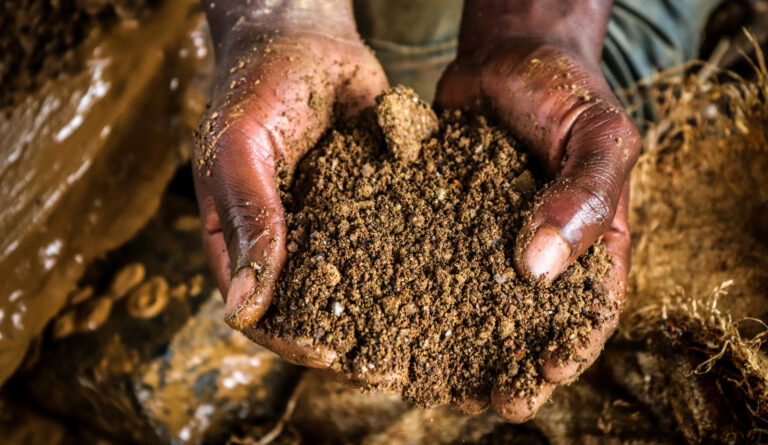Large open-cast mining operations are not only a reality specific to countries of the “South”. Not so far from us, in Andalusia, the mining revival that the European Union is calling for is in full swing. And there seems to be consensus between the different stakeholders. Yes, but at what price ? And for how long ? Invited by the French association Systext, Justice et Paix was able to immerse itself for a week in the reactivated mining history of southern Spain.

A strategy encouraged by the EU
For the European Commission, mining does not belong to the past, it is also our future. To achieve the ecological and digital transition, the European Union needs large quantities of metals. Lithium, cobalt, nickel, copper for batteries, rare earths for advanced digital, energy or defense technologies, among others[1]. The problem ? These resources are practically not exploited on European territory. “The EU depends 75% to 100% on imports for most metals”[2]. They mainly come from foreign countries including China, which remains a key part of global metals supply chains.
To ensure its energy independence, the European Union wants to reduce its dependencies[3] as much as possible. This is the objective announced from the “Raw Materials Initiative[4] » in 2008 which defines Europe's strategy for the supply of raw materials. It is accompanied by communication on “critical raw materials”, reissued every 3 years. The latest publication from 2020 states that the European Union will need 60 times more lithium, 15 times more cobalt and 10 times more rare earths by 2050[5].
Alongside recycling and securing its supplies through trade and diplomacy, the EU also strongly encourages Member States to (re)explore or even (re)exploit their own deposits. The European Alliance on Critical Raw Materials, created in 2020, is part of this strategy and aims, for the needs of European industry, to support this mining revival in Europe while trying to convince possible populations resistant to the the absolute necessity of these natural resources for the green transition[6].
Mining past and present in Andalusia
Spain, especially in the west, is one of the Member States with mining potential of economic interest: lithium, copper, gold, tin, rare earths, are present in the Spanish subsoil and could contribute to the project European energy transition. Western Andalusia is crossed by the Iberian pyrite belt which extends towards Portugal. “Portugal and Spain are the laboratories of large-scale mining in Europe,” says Juan Diego Pérez Cebada, professor of environmental history at the University of Huelva. Rich in copper, it is in this exceptional geological zone that several mining projects have been undertaken. Since 2009, 6 mines have reopened and hundreds of permits are under study.
In Spain, these are the autonomous communities[7] who have skills in subsoil management. They grant concessions and issue exploration permits to companies. “The Andalusian regional government is clearly positioning itself in favor of this mining recovery” explains Doris Buu Sao in her article on the subject. Lecturer at the University of Lille, she has been carrying out immersive research work on the Andalusian mining revival in Nerva for several months.[8]. In 2015, the region launched its “ mining strategy 2020 » to revitalize operations. “The authorities emphasize the potential of mining recovery in terms of employment and growth[9]”. To understand the rather positive reception given to this promotion of mining activities, the Andalusian socio-economic context provides useful insight. Andalusia is, in fact, the second poorest region in Spain, with a rate of 35.1% of its population at risk of poverty[10]. It was hit hard by the economic crisis of 2008. The current unemployment rate is 19% compared to 13% for the national average[11]. The mine is therefore presented as an economic opportunity that cannot fail to be seized. And a large segment of the population seems sensitive to these arguments. More recently, environmental reasons have finally legitimized the revival of this heavy industry. A " sustainable mining strategy » is currently being drafted by the head of the Andalusian government. Same at the national level with a “ roadmap for the sustainable management of mineral raw materials, fundamental for the success of the ecological and digital transition » of which the preliminary version has already been published. Everything is said, the lights are green, the mine has a future in Andalusia!
Furthermore, the mining revival in Andalusia is based on a long mining past which has forged a form of “mining culture”. Mining is in fact not a new subject in the South of Spain. Some deposits have been exploited since Roman times (Rio Tinto, Aznalcollar). From the second half of the 19th century to today, different periods of exploitation have followed one another, the intensity of which has fluctuated depending on the price of metals. Many villages were born near the mines. Some were destroyed when the exploitations ended. This explains a very strong attachment to this sector of activity in mining regions. Professor Pérez Cebada even speaks in certain cases of “amnesia of populations, loss of memory of their agrarian past. The names of the elements contribute to this forgetting. For example, in Aznalcollar, the river is called the Rio agro (acidic river), which makes people say that the river has always been polluted, but this is false. This pollution is due to mining from the last century and the river was previously called the Rio Crispinejo.”
On the need to nuance
North of the industrial city of Huelva is an active mining area. There is the Rio Tinto copper mine operated today by the Cypriot company with foreign capital Atalaya Mining. The mine employs between 800 and 1,200 people, 2/3 of whom work through subcontracting companies. If on the surface the mine seems to be favored by the population, academic, union and environmentalists are, however, more critical.
- Job insecurity:
Union mobilization has evolved significantly over time. At the beginning of the 20th century, very strong unions and workers' commissions emerged which mobilized to defend their jobs. One manifestation of this commitment was the formation of the workers' cooperative which attempted to maintain mining production activities at Rio Tinto between 1995 and 2001, following the company's departure. However, unions have lost legitimacy over time, particularly in connection with corruption cases. Note also that the business model of the 19th century is very different from that of the 20th century. The paternalistic company of the past has been replaced by the productivist multinational company of today. And this change directly influences relations with unions. The quest for maximum profit encroaches on workers’ rights.
Two union delegates from the Aguas Tenidas mine testified to this. They deplore the fact that subcontracting companies (from the construction and transport sectors) which are responsible for extraction and truck driving are not covered by the collective agreement for the mining sector which provides for bonuses for inhalation dust[12] notably. At the end of 2021, a consensus between unions, businesses and public authorities put an end to negotiations on this subject and now guarantees the limitation of temporary contracts as well as better harmonization between activity and collective agreement. But the law remains ambivalent according to some. AMINER, the employers' federation of the mining sector, reportedly declared that it could take advantage of the gaps left by the law to preserve its advantages.
Union demands of this type can give rise to abusive contract termination practices on the part of the company. Alfonso and Jorge[13] work in the Aguas Tenidas mine, located 2.5 hours from the Rio Tinto mine, on the Iberian pyrite belt. It was operated by the company MATSA[14] until 2021 then was bought by the Australian multinational Sandfire Resources in 2022. Alfonso works there in the concentration platform[15] and Jorge on the storage and supplies side. They are two of the rare employees to assume a union role, because “otherwise submission to the company would be total” explains Alfonso. They deplore the death of 5 of their colleagues since 2007. “The mining service and the labor inspectorate blame each other, the trials take time” they regret. On unfair dismissals, they explain that “two of our colleagues had been part of the works council but when you leave, after a year, you are no longer protected, so they were dismissed on the pretext of too low performance . They filed a complaint and the company, before the judgment, offered them compensation of 46,000 euros.” They also tell us that they have received threats and pressure on several occasions, notably from the human resources director. “The salary is high” they tell us “but it’s the politics of fear, the company buys our silence. In addition, the impacts of the dust breathed in will be felt in the long term and I do not want to sell my health for a salary” concludes Alfonso. “The pace of production is so frenetic, that’s what matters most, we are in the model of a colonial mine” concludes Jorge.
- Environmental risks:
The town of Nerva, populated by 5,000 inhabitants, is located at the foot of a mountain of mining waste (extracted useless rocks) several tens of meters high. Manuel, a former miner, explains to us that these waste rocks practically did not exist a few years ago. The intensive resumption of activities by Atalaya Mining since 2015 has caused the appearance of this artificial mountain. “One tonne of ore extracted represents 3 tonnes of waste rock. And the rate of ores processed today is unprecedented,” this retired miner tells us with pride. “At the end of the 90s, we processed 1000t/hour, today we are at more than 2000t/hour”. However, the Rio Tinto mine has a fairly low copper content of 0.48%[16]. Profitability comes from the volume extracted: we must therefore extract more and more.
From the top of the viewpoint to which Manuel takes us, we can not only observe the pile of waste rock but also part of the old site in operation between the end of the 19th and mid-20th centuries. We border the old ruined chimneys of the foundries of the time. “The manta (blanket) covered Nerva like a cloud of smoke reddened by the reflections of the sun” remembers Manuel. We can also notice mining residues (toxic treatment sludge) at the foot of the school in the town of Nerva, without this seeming to cause the slightest concern. Our question about health and environmental impacts is quickly brushed aside. It's not a subject. Manuel's nephew nevertheless informs us that a report on the dust emitted by extraction processes had almost been released in 2016 but that the company had reached an arrangement with the author so that it would never appear. He also regrets that there is not more compensation for the population. “The wealth of the company does not go to the population. In the past, it was more balanced,” he tells us bitterly.
We then take a vintage tourist train along the acid red Rio Tinto (Red River). The pollution of the river due to the mine has been proven in studies but the tour guide claims that it is a unique and harmless natural ecosystem. Astounded tourists take photographs along the river after crossing this apocalyptic environment made of piles of residue, waste rock and slag, millennia-old witnesses of the area's mining past. Manuel concludes our meeting by telling us how happy he is that his mining region can attract outside attention. Any idea that brings the economy to life appears positive to him, apart from the “Mars on Earth” attraction built by the Rio Tinto Foundation to provide a sensitive experience close to the planet Mars on an immense orange expanse of mining residue.
Besides the proximity between mine tailings rich in toxic heavy metals and residential areas, another problem greatly concerns environmentalists. These are the tailings ponds from the Rio Tinto mine. Isidoro Albarreal, specialist in mining issues atenvironmentalists in action (national environmental association), explains to us that these basins are around 500 hectares and are filled with 200 million tonnes of sludge. These toxic sludges come from concentration and hydrometallurgy platforms[17] which use different chemical reagents to purify the ore. “The method of construction of the mining dam is the most dangerous that exists” points out Isidoro, “the risk of rupture is very real and would cause a dramatic natural disaster which would pollute the waterways and the land all the way to the sea and would also affect the Doñana Natural Park”. The Atalaya Mining company currently wishes to further increase the capacity of the basins by raising the dam by 42 meters to accommodate 160 million tonnes of additional tailings. Authorization has not yet been granted.
Take the necessary step back
Faced with the realities observed, it is neither easy nor undoubtedly desirable to decide “for” or “against” the mine. In the Rio Tinto mining basin, economic opportunities other than the mine (and the few tourist facilities that surround it) seem non-existent for the populations. The region is devastated by waste from past and present operations which prevents any agricultural activity, for example. The mine seems to be the only option. And our position as an observer is being undermined in the face of denial regarding the obvious pollution of these areas and the probable health impacts. When a population does not wish to be fully aware of these impacts, is this not a choice that concerns them above all?
However, certain company practices remain unacceptable and do not seem to control all risks. Whether it is anti-union methods or the risks identified around Rio Tinto's mine tailings ponds, the room for improvement is very real. These practices must be able to be denounced without fear of reprisals and human rights should take precedence over economic profitability. Our discovery of the Spanish mining reality allowed us to note that practices were no more exemplary in the European Union than in Peru or DR Congo, undermining the sector's arguments. The green mine does not exist.
Finally, should the ecological and digital transition of the European Union be carried out at the cost of sacrificing certain territories, natural environments and waterways? The growing demand for metals will strengthen the desire of various public and private actors to bring projects to fruition in the European Union (and elsewhere in the world). The consent of the population is far from guaranteed and must be able to be listened to. The NYMBI[18], frequently denounced by mine promoters (“you want a smartphone but not a mine near you”), is understandable from the moment he pleads for another model of society, a model where blind extractivism would give way the place for a more measured and reasonable model, where collective sobriety would be considered as a real option and implemented democratically, a model which would aim to definitively escape from the current abstruse myth of abundance, to not further damage our planet and to see what we can do with what exists.
Geraldine Duquenne.
[1] file:///C:/Users/geraldine/Downloads/Raw%20materials%20factsheet.pdf
[2] Communication on Critical Raw Materials from the European Commission, 2020, p. 7.
[3] In the “Critical Raw Materials” 2020 communication, the European Commission lists 30 critical raw materials whose criticality is determined by economic importance and supply risk, among which we find, among others, antimony, bauxite, lithium, indium, cobalt, tantalum, etc.
[5] https://eur-lex.europa.eu/legal-content/FR/TXT/PDF/?uri=CELEX:52020DC0474&from=EN
[6] See on their website https://erma.eu/
[7] The autonomous communities are the first level of territorial subdivision of the Kingdom of Spain. There are 17 of them. They benefit from legislative and executive power.
[8] See his article “Bringing “sustainable” mining to Europe? Institutional discourses and the imperative of mining recovery, from the European Union to Andalusia”
[9] Buu Sao Doris, “Bringing “sustainable” mining to Europe? Institutional discourses and the imperative of mining recovery, from the European Union to Andalusia”, Governance Review, Volume 18, number 2, 2021, p. 23
[10] https://www.eapn.es/estadodepobreza/ARCHIVO/documentos/informe-AROPE-2021-resumen-ejecutivo.pdf
[11] https://www.epdata.es/datos/paro-cada-comunidad-autonoma-epa-ine/11/andalucia/290
[12] Dust is one of the impacts of mining, whether in the transport of ores, grinding and crushing or in the concentration stages, hydrometallurgy or pyrometallurgy. Loaded with heavy metals, they can have an impact on the health of workers.
[13] Borrowed first names
[14] The mine was bought at 100% by the Australian company Sandfire Resources in 2022
[15] The concentration process is the exploitation stage which follows the grinding and crushing stage. It aims to treat the dust obtained, generally by flotation, to obtain dust with a higher metallic concentration. Flotation is a solution which, by density, will bring up the richest metals. The concentrate, for example, of copper obtained has a copper content of 25 to 40%. Other steps follow until the pure metal is obtained.
[16] The global average is currently around 0.6%, which means that 60kg of copper is extracted from one tonne of rock.
[17] Process which follows concentration and which aims to further purify the ore on the basis of dissolution.
[18] Means “Not in my BackYard”, in French “not in my backyard”





